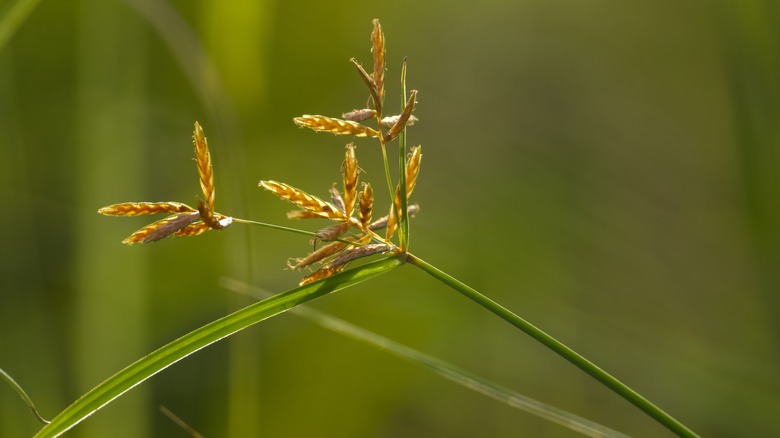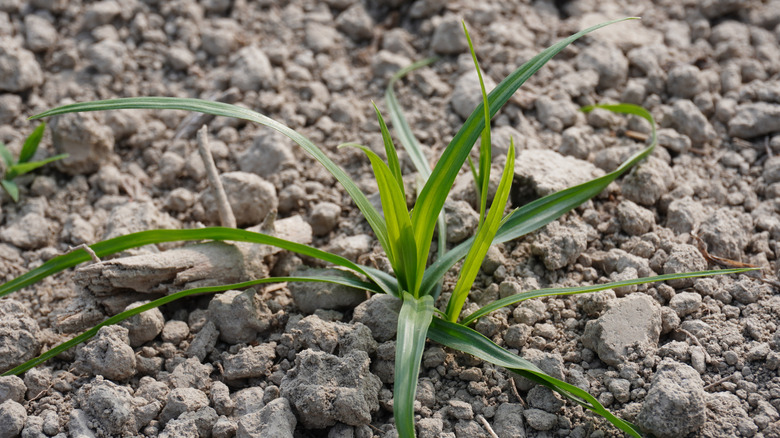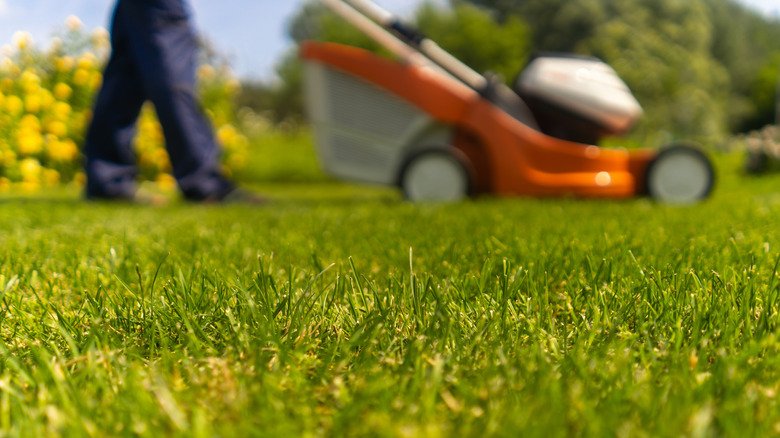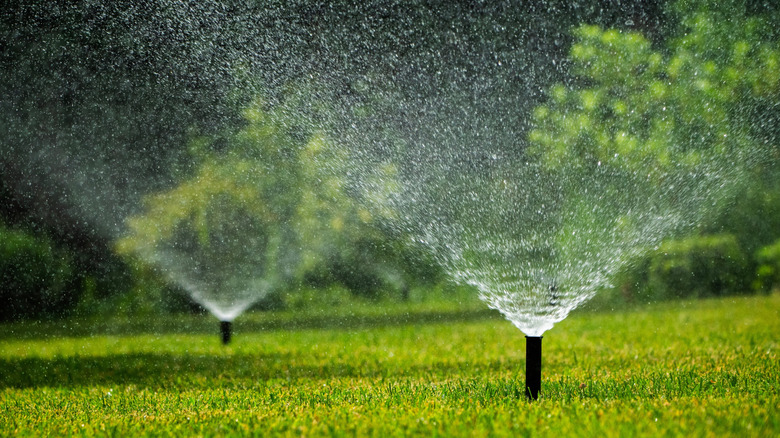Tips For Killing Nutsedge (And The Biggest Mistakes To Avoid)
We may receive a commission on purchases made from links.
Discovering any weeds growing in your lawn and garden is never fun. However, some weeds are particularly difficult to get rid of, and when you spot one of them starting to take over your space, it can be exceedingly frustrating. Nutsedge is one of these weeds that no one wants to spy growing in their garden or on their lawn. If you've never heard of nutsedge before, it's a perennial weed with thick leaves that look similar to grass blades. Also known as nutgrass, these pesky plants grow quickly and can be very aggressive. Purple and yellow nutsedge are two of the most common species. Both of these species grow tubers on their stems beneath the ground. If left to grow, these tubers can reach depths of up to 14 inches. With the new plants that grow from these tubers, a single weed can quickly turn into a large patch with a diameter that is easily 10 feet.
As you can tell, the weed is nothing to mess around with. Once an infestation starts, it can be extremely difficult to get rid of. Knowing the best eradicating methods — as well as the mistakes that will be a waste of your time and effort — is essential if you want to clear up the problem before it escalates. Ahead, we've put together a list of some tips to help you kill nutsedge. We'll also share some common errors that could set your efforts back.
Act quickly to limit how many tubers can be produced
If you want to stop a new nutsedge problem from growing exponentially, then it is essential to act quickly to remove plants while they are still small, before they have the chance to develop tubers. Nutsedge doesn't start developing tubers until it has at least five leaves, so if you're paying attention and catch individual new plants right in their early stage of growth (before they've spread into a patch), you should be able to pull them before the tubers start to grow. Maintaining a schedule of weeding every two to three weeks during the summer months will help you achieve this goal.
The reason it is so essential to limit the production of tubers is that they are the part of the weed that is responsible for its growth and how quickly it can spread throughout a lawn or garden. These tubers sprout new roots that spread beneath the surface. By the time you realize that there is a problem, the weed may have already spread across much of your yard.
Beyond limiting the spread of the weed, removing the tubers can also help weaken it. As you continually pull the small nutsedge shoots from your garden or yard, the existing tuber beneath the ground will need to devote the energy it has to sprouting a new bud, and growing new leaves, instead of producing additional tubers. Over time, the energy reserves will be depleted, resulting in weaker sprouts (though these can still grow new tubers, so you should be careful not to let your guard down).
Be sure to remove the entire (mature) plant with hand-pulling or hoeing
When you're removing more mature nutsedge plants from your lawn or garden, simply cutting off what you see above the surface or pulling it out won't be enough to kill the entire weed. Instead, it is essential to make sure that the entire plant — above and below the surface — is removed. You must be sure that you get the basal bulb out, and any tubers. The basal bulb is the underground shoot of the plant where groups of leaves grow from. If you don't remove this bulb, new leaves will simply grow in place of the ones you pulled.
To make sure you fully remove the entire nutsedge plant, you'll have to be ready to get a bit dirty. Because of how deep the weed can grow, use your hoe to dig a hole of up to 14 inches until you locate the basal bulb and any tubers. Continue this routine every few weeks with any weeds that have fewer than six leaves.
While hand-pulling or hoeing young nutsedge plants can be an effective method of control, it is essential to avoid trying to hand-pull mature plants (those with six or more leaves). Once the plant matures to this stage, it will have also developed those tubers beneath the surface. If you try to pull these plants out, then the tubers will be shifted underground and, soon, will resprout and continue spreading.
Cut the grass frequently and to a low height when you notice the first signs of an infestation
Understanding the right length to mow your lawn to is important for all homeowners. But, for those dealing with a nutsedge problem, it can be even more important. If you neglect cutting your grass — or don't cut it short enough — nutsedge will be more likely to grow and spread across the lawn. The reason for this is that when you're not regularly cutting off the top of the weed as you mow, the nutsedge will need to expend less energy on sprouting new leaves to replace what was removed. Instead, it will be able to conserve its energy and put more of it to work at growing tubers and spreading underground.
However, before you grab your mower and start cutting several inches off of your grass that has already gotten too tall, there are some important considerations to keep in mind. First, it is essential to avoid cutting too much height off at any given time. You shouldn't remove more than one-third of the height with any mow, or you'll run the risk of weakening your turf and making the grass less dense. Doing so can create conditions that are even more favorable to nutsedge taking over. So if your lawn has already gotten pretty long, reduce the height in stages, and then maintain it at a shorter length.
The ideal height to keep your turf at for minimizing nutsedge growth is between 3 and 3.5 inches. Cutting it lower than this can also be an issue. The weed, particularly yellow nutsedge, can really start taking over when the grass is cut too short. So, aim to mow frequently so you can cut off no more than one-third of the grass' height to keep it between 3 and 3.5 inches.
Suppress the plant's growth using polypropylene landscape fabric
You may have heard that mulching can suppress a weed's ability to grow. While this is true, nutsedge is not just your average weed, so you'll need to be very purposeful about the types of materials you use to try to suppress its ability to sprout to the surface. Unfortunately, polyethylene plastic mulches that you may use to control other weeds won't be sufficient to keep nutsedge from growing. The leaves are so thick and have such sharp tips that they'll be able to push their way through these types of mulch.
As you can see, the best type of landscape fabric to control weeds can depend on the species. In the case of suppressing nutsedge, the best solution is to use a polypropylene polymer landscape fabric, such as the Hoople Landscape Fabric. These landscaping fabrics are typically thick enough to prevent the sharp leaves from poking through and making their way to the surface. Because polypropylene polymer landscape fabric is permeable, moisture and air will still be able to reach the soil to support the plants you want to survive.
Be careful not to inadvertently introduce nutsedge to new areas of your lawn
If you're planning a landscaping project in your yard, you must be careful to avoid inadvertently introducing nutsedge to new areas. Many projects will require you to either move or bring additional soil to the site, and if you make the mistake of choosing soil that holds nutsedge, you'll be setting yourself up for a major hassle. The problem is, however, that you can't always tell whether nutsedge is lurking in soil. Even if you don't see any weeds actively growing, there may still be dormant tubers that are present. Stirring them up when you move the soil to a new location could be just what they need to start growing and spreading again.
So, what should you do when you need new soil for a project in your yard? If you only need a small quantity, and are planning to simply move soil from another location in your yard, be extra careful. Avoid transferring dirt from any spots where you've ever had a nutsedge problem. If you need to bring soil in from outside, look for sources that offer NAISMA-certified products. Verified by the North American Invasive Species Management Association, these soils should be free of nutsedge (and other invasive weeds) that can put a damper on your new project.
Work to improve the overall health and density of your lawn
We touched on this earlier, but nutsedge will spread much more easily and quickly through a lawn that is not dense and healthy. So, it stands to reason that focusing at least some of your efforts on improving the health of your lawn and working to make your grass grow in thick and dense should help limit the spread of any nutsedge.
Beyond following proper mowing protocols, you can also help create a dense turf by avoiding common mistakes when watering your lawn. For example, watering in the early morning hours when the soil will have a chance to absorb the moisture, instead of during the heat of the day when much of the water will be lost to evaporation, is important. Similarly, take care to avoid watering too frequently, as it can result in shallow-rooted grass, instead of a lawn that is deeply rooted and stronger. Nutsedge also loves overly wet, waterlogged soil — to the point where infestations can sometimes even be a sign of irrigation issues like leaking sprinklers. So if you're prone to overdo the watering, dial back, and consider purchasing a moisture meter (something simple like the Xlux Soil Moisture Meter should be adequate) so you can accurately gauge the soil moisture content at the root zone of your turf and in garden beds.
Proper watering isn't the only thing your lawn needs to grow lush and dense. It is also important to apply fertilizer to ensure that the grass is given the nutrients it needs to remain healthy, and you should also look at other best practices, such as utilizing the overseeding technique on your lawn, topdressing, and aerating.
Take steps to improve drainage
Nutsedge is most likely to spread in lawns that don't have adequate drainage. Like we mentioned above, the weed thrives in moist conditions and, especially when sunlight is plentiful too, will quickly spread and cause problems. Therefore, taking steps to improve drainage in your yard can help prevent it from spreading so quickly.
There are various ways to improve drainage solutions in a yard or garden, such as adding a French drain, grading slopes properly so water doesn't pool, amending soil, and more. You may want to consult with a professional landscaper or water control expert to determine the specific needs of your lawn or yard. While some properties may require modifications to improve surface drainage, such as by adding a water removal system, other properties may simply need to be aerated to reduce soil compaction and improve internal drainage.
While improving drainage may help prevent a future infestation, it is important to understand that it likely won't resolve your current issue. While nutsedge spreads best in moist conditions, once the weed has established itself, it is very persistent. At this point, it can even withstand drought-like conditions.
Avoid picking the wrong chemical herbicides
If you didn't understand it before, by now you're likely realizing just how difficult handling a nutsedge infestation in your lawn can be. Because of this, many professionals recommend using herbicides to kill the weed, especially when you're dealing with a large infestation. However, if you just pick up any herbicide from the store shelves or online, you might end up choosing something that isn't going to be effective — as not many herbicides can tackle this pernicious weed. If you wish to try chemical control, you'll want to look for a herbicide that lists either halosulfuron or sulfentrazone as its active ingredient, such as Sedgehammer Turf Herbicide (its active ingredient is halosulfuron). However, don't expect to see immediate results; halosulfuron can take up to 4 weeks to kill nutsedge.
Because of how challenging nutsedge can be to get rid of — and how limited the selection of control options you'll find at standard stores is — this may be the time to call in a professional. They have access to more herbicides that aren't available to non-professionals. For example, they may recommend one that features imazosulfuron, dichlobenil, or mesotrione as its active ingredient.
It is also important to note that even if you hire a professional, multiple years of treatment will be necessary to clear up a nutsedge problem. Because of how resilient the tubers can be — and the fact that they can remain dormant in the soil — a single herbicide application will not be sufficient.
Avoid waiting until you see the weed to start taking action
Even when you use one of the approved herbicides — and have a professional apply it — the weed is likely to return the following season. Since you know it is likely to pop back up, you should avoid waiting around for the patch to sprout before you begin taking action. The longer you wait, the more likely it is that the shoots will have the opportunity to produce tubers, which is the last thing you want if you're trying to prevent nutsedge from taking over.
So, make a plan to target nutsedge before you see it emerge in any areas where it was a problem last year. Many of the herbicides that are commercially available are not pre-emergents, so they won't prevent nutsedge from growing. However, one option you can try is Casoron 4G which lists dichlobenil as its active ingredient. It can be effective at targeting the weed before it starts growing (but only yellow nutsedge). The other active ingredient in herbicides that can be applied before you see the plants is dimethenamid-P. However, this is not in any products that are available to home gardeners, so you'll need to contact a professional company.
Avoid applying ALS-inhibiting herbicides more than twice each season
Many of the chemical herbicides that are effective for targeting nutsedge are ALS inhibitors. As their name suggests, these chemicals work by inhibiting the ALS enzyme, which is essential for nutsedge producing branched-chain amino acids and spurring new growth. Some of the common nutsedge herbicides that are considered ALS inhibitors include Sedgehammer, Monument, Vexis, and Katana. These are also post-emergent herbicides, which means they are applied after the weed has started growing. Once applied, they work their way to the tubers and effectively stunt their maturation as well as the plant's ability to produce new tubers.
Most ALS inhibitors will be effective when they are applied twice each season — between two and six weeks apart, depending on the specific product. However, as effective as these can be — and as tempting as it may be to work in an extra application to really give that pesky nutsedge a run for its money — you should avoid doing so. If applied more than two times within a single season, it is more likely that the nutsedge will become resistant to the herbicide. Instead, stick to the two applications per season and implement other control methods between and after.
Avoid trying a hack that will likely prove to be a waste of time
Considering how annoying nutsedge can be, it's no wonder that home gardeners (and many professionals) have tried throwing just about everything at it to see what will work. As you're exploring the best removal options, you may come across several hacks on TikTok or gardening sites. However, most of these hacks will likely prove to be a waste of your time and will only give the nutsedge more opportunity to spread before you realize that the approach didn't actually do anything.
The reason most hacks are ineffective for nutsedge comes back to the fact that it is simply a very persistent and difficult to kill weed. For example, one suggestion you might encounter is to smother the nutsedge by piling newspaper up over it. However, as we shared earlier, even standard mulch isn't effective at preventing its growth because the shoots will poke their way through, so it's unlikely that newspaper is going to be a match for its might. There are plenty of weeds where you can consider natural DIY weed barrier alternatives to landscape fabric, but nutsedge isn't one of them.
Another trick that you might see recommended is to cover infested areas with granulated sugar multiple times throughout the growing season to prevent it from spreading. Sugar is most likely to be effective with herbaceous annual weeds. Nutsedge is a perennial weed that's not going to be held back by this hack.











